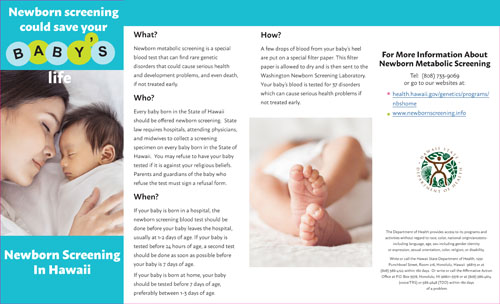Newborn Metabolic Screening Program

All parents want healthy babies. However, some children are born with errors in their body chemistry that often show no outward symptoms. If these rare but serious conditions are not discovered early, poor physical and mental development, and even death, may occur. To make sure infants at risk are identified, the State of Hawaiʻi requires screening of all newborns for certain genetic/metabolic disorders. If found and treated before symptoms appear, babies born with these disorders may lead a normal, healthy life.
In Hawaiʻi, all newborns are checked for thirty-three different disorders. They are:
Endocrine (hormone) disorders:
- Congenital adrenal hyperplasia in which the adrenal glands are unable to produce normal amounts of certain hormones.
- Congenital hypothyroidism in which the thyroid gland cannot make enough thyroid hormone for normal body and brain growth.
Hemoglobin (blood) disorders:
- Sickle cell disease and other hemoglobinopathies in which abnormal hemoglobin in the red blood cells may cause anemia.
Other disorder:
- Cystic Fibrosis
- Severe Combined Immunodeficiency (SCID)
- Pompe
- Mucopolysaccharidosis Type 1 (MPS I)
- Spinal Muscular Atrophy (SMA)
- X-linked Adrenoleukodystrophy (X-ALD)
Metabolic (metabolism) defects:
- Biotinidase deficiency in which the body is unable to use biotin, a B-vitamin.
- Galactosemia in which the body cannot break down a sugar (galactose) found in milk.
- Amino acid (protein) disorders: a group of hereditary disorders caused by enzymatic defects, which result in the toxic accumulation of certain amino acids in the blood.
- Homocystinuria
- Maple Syrup Urine Disease (MSUD)
- Phenylketonuria (PKU)
- Tyrosinemia (Types I )
- Fatty acid oxidation disorders: a group of hereditary disorders caused by defects in enzymes which are involved in the breakdown of dietary and stored fats to energy.
- Medium chain acyl-CoA dehydrogenase deficiency (MCADD)
- Long chain 3-hydroxyacyl-CoA dehydrogenase deficiency (LCHADD)
- Very long chain acyl-CoA dehydrogenase deficiency (VLCADD)
- Carnitine uptake/transport defects
- Trifunctional Protein Deficiency (TFP)
- Organic acid disorders: a group of hereditary disorders caused by enzymatic defects which result in a toxic accumulation of certain organic acids in the blood.
- Beta-ketothiolase deficiency (BKD)
- Glutaric acidemia Type I (GA-1)
- Isovaleric acidemia (IVA)
- Methylmalonic acidemia (MMA)
- Multiple carboxylase deficiency (MCD)
- Propionic acidemia (PA)
- Urea cycle disorders: a group of hereditary disorders, caused by enzymatic defects which result in a toxic accumulation of ammonia in the blood.
- Citrullinemia (ASAS)
Some disorders are treated with special diets, and other disorders are treated with medications. If treated early, infants may grow up to lead a normal, healthy life. In a few cases, the disorders may not be completely treatable. The early diagnosis and treatment of the disorder will allow your baby the best chance of normal growth and development.
- The test should be done before your baby leaves the hospital.
- If your baby is tested before 24 hours of age, a second test should be done before your baby is 2 weeks old.
- If your baby is born at home, your baby should be tested before 7 days of age.
The laboratory uses the baby’s dried blood sample from the test paper to test for the conditions on the Hawaiʻi newborn screening panel. After testing, a small amount of dried blood remains on the test paper. This left over dried blood sample is called a residual dried blood spot (RDBS). Hawaii’s residual dried blood spots are securely stored at the laboratory for one year. This is important should a baby require re-testing to confirm the baby’s laboratory results. After one year, the stored blood spots are destroyed.
The residual dried blood spots may be used for quality assurance and quality improvement activities. Quality assurance and quality improvement activities might include making sure the laboratory’s equipment is working correctly or help in the improvement or development of new newborn screening tests.
Some states use the blood spots for identified research activities. Identified research activities are when the baby’s identity (baby’s name or parents’ names) is linked to the blood spot. Hawaiʻi does not use residual dried blood spots for identified research activities.
Newborn Screening for Critical Congenital Heart Defects
A Hawaiʻi state law (House Bill 467, H.D.1, S.D.1) was passed in 2015 mandating that each baby born in a hospital be screened for critical congenital heart defects (CCHD). Typically, these types of heart defects lead to low levels of oxygen in a baby and may be identified using pulse oximetry screening at least 24 hours after birth. Pulse oximetry is a simple, quick and painless way to measure how much oxygen a baby has in his or her blood. Babies who have low oxygen levels may have a CCHD and may need further testing.
CCHD describes a group of heart defects that can cause life-threatening problems which need to be treated within the first days or first year of life. Here are a few examples of CCHDs.
- Hypoplastic left heart syndrome
- Pulmonary atresia
- Tetralogy of Fallot
- Total anomalous pulmonary venous return
- Transposition of the great arteries
- Tricuspid atresia
- Truncus arteriosus
